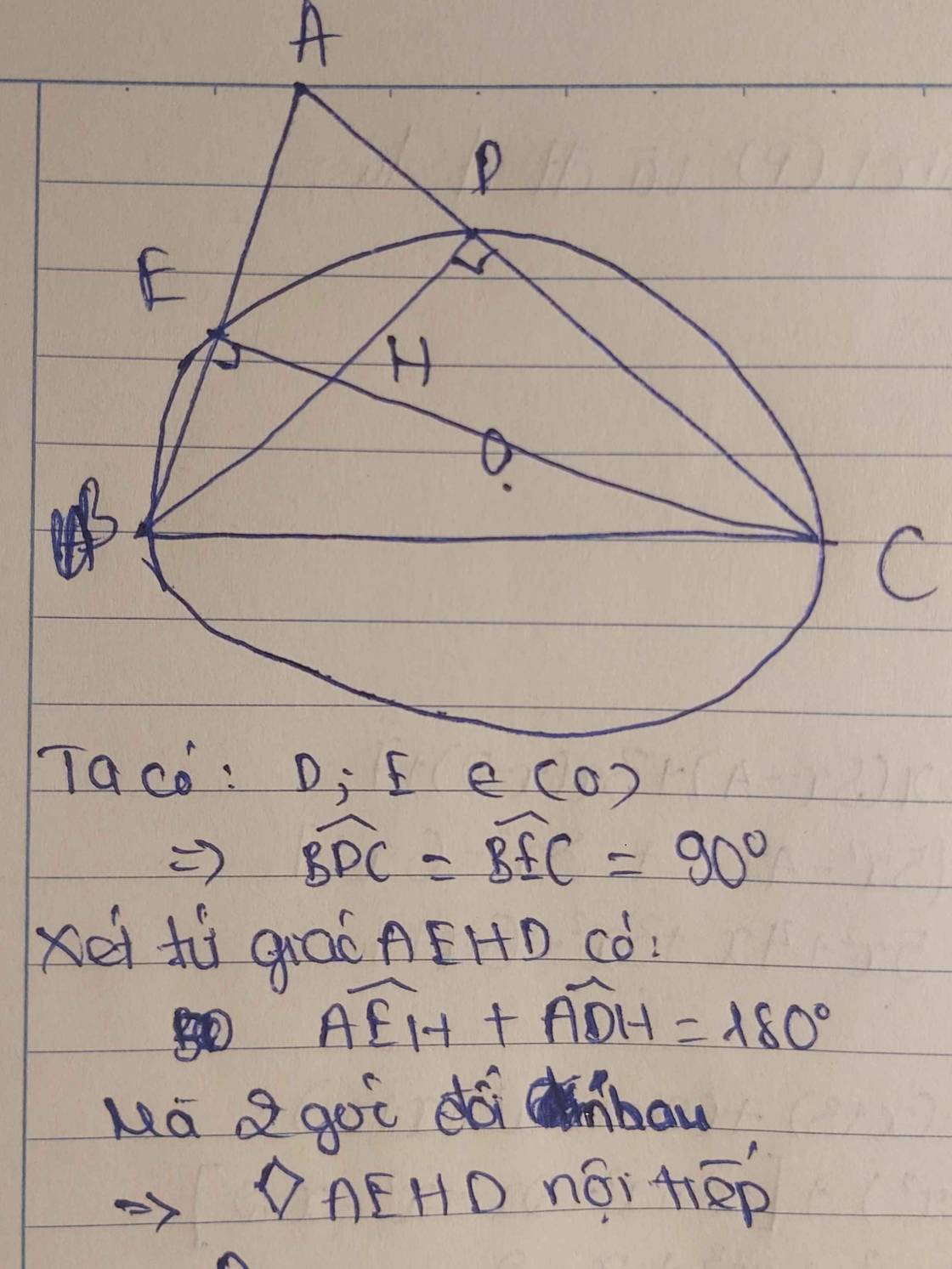cho đường tròn (o) và dây cung BC cố định không phải đuờng kính, M là trug điểm của BC. Điểm A thay đổi trên (O) sao cho tam giác ABC nhọn, không cân. Gọi H là trực tâm của tam giác ABC và E,F lần lượt là chân các đường cao hạ từ các đỉnh B,C. Đường tròn đường kính AH cắt AM tại K khác Aa) c/m ME,MF là hai tiếp tuyến của đường tròn đường kính AH và MK.MA= ME2
Hãy nhập câu hỏi của bạn vào đây, nếu là tài khoản VIP, bạn sẽ được ưu tiên trả lời.

\(\text{Δ}=\left(-2m\right)^2-4\left(m^2-m\right)\)
\(=4m^2-4m^2+4m=4m\)
Để phương trình có hai nghiệm dương phân biệt thì \(\left\{{}\begin{matrix}\text{Δ}>0\\-\dfrac{b}{a}>0\\\dfrac{c}{a}>0\end{matrix}\right.\)
=>\(\left\{{}\begin{matrix}4m>0\\2m>0\\m^2-m>0\end{matrix}\right.\)
=>\(\left\{{}\begin{matrix}m>0\\m\left(m-1\right)>0\end{matrix}\right.\Leftrightarrow m>1\)
\(\sqrt{x_1}=\sqrt{3x_2}\)
=>\(\left\{{}\begin{matrix}x_1>=0\\x_2>=0\\x_1=3x_2\end{matrix}\right.\)
\(x_1+x_2=-\dfrac{b}{a}=2m\)
=>\(3x_2+x_2=2m\)
=>\(x_2=0,5m\)
=>\(x_1=1,5\cdot m\)
\(x_1\cdot x_2=\dfrac{c}{a}=m^2-m\)
=>\(m^2-m-0,75m^2=0\)
=>\(0,25m^2-m=0\)
=>\(m\left(0,25m-1\right)=0\)
=>\(\left[{}\begin{matrix}m=0\left(loại\right)\\m=4\left(nhận\right)\end{matrix}\right.\)
\(\Delta'=m^2-\left(m^2-m\right)=m>0\)
Theo hệ thức Viet: \(\left\{{}\begin{matrix}x_1+x_2=2m\\x_1x_2=m^2-m\end{matrix}\right.\)
Để biểu thức đề bài xác định \(\Rightarrow\left\{{}\begin{matrix}x_1+x_2=2m>0\\x_1x_2=m^2-m\ge0\end{matrix}\right.\)
\(\Rightarrow m\ge1\)
Khi đó:
\(\sqrt{x_1}=\sqrt{3x_2}\Rightarrow x_1=3x_2\)
Thế vào \(x_1+x_2=2m\Rightarrow4x_2=2m\Rightarrow x_2=\dfrac{m}{2}\)
\(\Rightarrow x_1=\dfrac{3m}{2}\)
Thế vào \(x_1x_2=m^2-m\)
\(\Rightarrow\dfrac{3m^2}{4}=m^2-m\)
\(\Rightarrow m^2-4m=0\Rightarrow\left[{}\begin{matrix}m=0\left(loại\right)\\m=4\end{matrix}\right.\)

ĐKXĐ: \(\left\{{}\begin{matrix}y\ge\dfrac{3}{2}\\x\ge-5\end{matrix}\right.\)
Từ pt đầu:
\(x^2+6x+9=12y^2-4xy-4x+12y=0\)
\(\Leftrightarrow\left(x^2+4xy+4y^2\right)+10\left(x+2y\right)+25-16\left(y^2+2y+1\right)=0\)
\(\Leftrightarrow\left(x+2y+5\right)^2-\left(4y+4\right)^2=0\)
\(\Leftrightarrow\left(x+6y+9\right)\left(x-2y+1\right)=0\)
\(\Rightarrow\left[{}\begin{matrix}x+6y+9=0\\x-2y+1=0\end{matrix}\right.\)
- Với \(x+6y+9=0\Leftrightarrow\left(x+5\right)+6y+4=0\) (vô nghiệm do \(x\ge-5\) và \(y\ge\dfrac{2}{3}\))
- Với \(x=2y-1\) thay vào pt dưới:
\(\sqrt{3y-2}-\sqrt{y+2}=2y^2-3y-2\)
\(\Leftrightarrow\dfrac{2\left(y-2\right)}{\sqrt{3y-2}+\sqrt{y+2}}=\left(y-2\right)\left(2y+1\right)\)
\(\Rightarrow\left[{}\begin{matrix}y=2\Rightarrow x=3\\\dfrac{2}{\sqrt{3y-2}+\sqrt{y+2}}=2y+1\left(1\right)\end{matrix}\right.\)
Xét (1), do \(y\ge\dfrac{3}{2}\Rightarrow\dfrac{2}{\sqrt{3y-2}+\sqrt{y+2}}\le\dfrac{2\sqrt{14}}{7}< 2\)
Mà \(2y+1\ge\dfrac{4}{3}+1>2\)
\(\Rightarrow\left(1\right)\) vô nghiệm

a. Với mọi a;b;c ta có:
\(\left(a-b\right)^2+\left(b-c\right)^2+\left(c-a\right)^2\ge0\)
\(\Leftrightarrow a^2+b^2+c^2\ge ab+bc+ca\)
\(\Leftrightarrow a^2+b^2+c^2+2ab+2bc+2ca\ge3ab+3bc+3ca\)
\(\Leftrightarrow\left(a+b+c\right)^2\ge3\left(ab+bc+ca\right)\)
Dấu "=" xảy ra khi \(a=b=c\)
b.
Ta có: \(\dfrac{a}{1+b^2}=a-\dfrac{ab^2}{1+b^2}\ge a-\dfrac{ab^2}{2b}=a-\dfrac{ab}{2}\)
Tương tự: \(\dfrac{b}{1+c^2}\ge b-\dfrac{bc}{2}\) ; \(\dfrac{c}{1+a^2}\ge c-\dfrac{ac}{2}\)
Cộng vế:
\(\dfrac{a}{1+b^2}+\dfrac{b}{1+c^2}+\dfrac{c}{1+a^2}\ge a+b+c-\dfrac{ab+bc+ca}{2}\ge a+b+c-\dfrac{\left(a+b+c\right)^2}{6}=\dfrac{3}{2}\)
Dấu "=" xảy ra khi \(a=b=c=1\)

Đề bài chính xác là \(a;b;c>0\) (ko hiểu dấu = có ý nghĩa gì khi mà các mẫu số đều phải khác 0 nên hiển nhiên a;b;c đều khác 0)
Đặt \(P=\dfrac{1}{a^2+b^2+c^2}+\dfrac{1}{ab}+\dfrac{1}{bc}+\dfrac{1}{ca}\)
Do \(\dfrac{1}{ab}+\dfrac{1}{bc}+\dfrac{1}{ca}\ge\dfrac{9}{ab+bc+ca}\)
\(\Rightarrow P\ge\dfrac{1}{a^2+b^2+c^2}+\dfrac{9}{ab+bc+ca}\)
\(P\ge\dfrac{1}{a^2+b^2+c^2}+\dfrac{1}{ab+bc+ca}+\dfrac{1}{ab+bc+ca}+\dfrac{7}{ab+bc+ca}\)
\(P\ge\dfrac{9}{a^2+b^2+c^2+2\left(ab+bc+ca\right)}+\dfrac{7}{\dfrac{\left(a+b+c\right)^2}{3}}\)
\(P\ge\dfrac{30}{\left(a+b+c\right)^2}=30\)
Dấu "=" xảy ra khi \(a=b=c=\dfrac{1}{3}\)

đk: \(-2\le x\le4\)
Ta có \(P^2=\left(\sqrt{x+2}+\sqrt{4-x}\right)^2\)
\(\le2\left[\left(\sqrt{x+2}\right)^2+\left(\sqrt{4-x}\right)^2\right]\) (dùng BĐT \(\left(a+b\right)^2\le2\left(a^2+b^2\right)\))
\(=2\left(x+2+4-x\right)\)
\(=12\)
\(\Rightarrow P\le2\sqrt{3}\) (vì \(P>0\))
Dấu "=" xảy ra \(\Leftrightarrow x+2=4-x\Leftrightarrow x=1\)
Vậy GTLN của P là \(2\sqrt{3}\) khi \(x=1\)
Ta có: \(P=\sqrt{x+2}+\sqrt{4-x}\left(-2\le x\le4\right)\)
\(\Leftrightarrow P^2=\left(\sqrt{x+2}+\sqrt{4-x}\right)^2\)
\(\Leftrightarrow P^2=x+2+4-x+2\sqrt{\left(x+2\right)\left(4-x\right)}\)
\(\Leftrightarrow P^2=6+2\sqrt{\left(x+2\right)\left(4-x\right)}\)
Mà: \(6+2\sqrt{\left(x+2\right)\left(4-x\right)}\le6+x+2+4-x=12\)
\(\Leftrightarrow P^2\le12\)
\(\Leftrightarrow P\le2\sqrt{3}\)
Dấu "=" xảy ra khi: \(x+2=4-x\Leftrightarrow2x=2\Leftrightarrow x=1\)
Vậy: \(P_{max}=2\sqrt{3}\Leftrightarrow x=1\)

Đây là bài toán lãi suất kép trong chương trình 12 chứ ko phải lớp 9

Ta có \(\dfrac{1}{\left(a+1\right)\sqrt{a}+a\sqrt{a+1}}\)
\(=\dfrac{1}{\sqrt{a\left(a+1\right)}\left(\sqrt{a+1}+\sqrt{a}\right)}\)
\(=\dfrac{\sqrt{a+1}-\sqrt{a}}{\sqrt{a\left(a+1\right)}\left(\sqrt{a+1}+\sqrt{a}\right)\left(\sqrt{a+1}-\sqrt{a}\right)}\)
\(=\dfrac{\sqrt{a+1}-\sqrt{a}}{\sqrt{a\left(a+1\right)}}\)
(vì \(\left(\sqrt{a+1}+\sqrt{a}\right)\left(\sqrt{a+1}-\sqrt{a}\right)=\left(a+1\right)-a=1\))
\(=\dfrac{1}{\sqrt{a}}-\dfrac{1}{\sqrt{a+1}}\)
Do đó \(B=\dfrac{1}{\sqrt{1}}-\dfrac{1}{\sqrt{2}}+\dfrac{1}{\sqrt{2}}-\dfrac{1}{\sqrt{3}}+...+\dfrac{1}{\sqrt{99}}-\dfrac{1}{\sqrt{100}}\)
\(=1-\dfrac{1}{10}\)
\(=\dfrac{9}{10}\)

\(\Leftrightarrow\left(x-1\right)^2=27y^3+1\)
\(\Leftrightarrow\left(x-1\right)^2=\left(3y+1\right)\left(9y^2-3y+1\right)\)
Gọi \(d=ƯC\left(3y+1;9y^2-3y+1\right)\)
\(\Rightarrow3y\left(3y^2+1\right)-\left(9y^2-3y+1\right)⋮d\)
\(\Rightarrow6y-1⋮d\)
\(\Rightarrow2\left(3y+1\right)-\left(6y-1\right)⋮d\)
\(\Rightarrow3⋮d\)
Mà \(3y+1⋮d\Rightarrow d\ne3\)
\(\Rightarrow d=1\)
\(\Rightarrow3y+1\) và \(9y^2-3y+1\) nguyên tố cùng nhau
\(\Rightarrow3y+1\) và \(9y^2-3y+1\) đều là SCP
\(\Rightarrow9y^2-3y+1=n^2\)
\(\Leftrightarrow36y^2-12y+4=4n^2\)
\(\Leftrightarrow\left(6y-1\right)^2+3=\left(2n\right)^2\)
\(\Leftrightarrow\left(2n+6y-1\right)\left(2n-6y+1\right)=3\)
\(\Rightarrow y=0\Rightarrow x=\left\{0;2\right\}\)

Do BC là đường kính (O) và D thuộc (O) \(\Rightarrow\widehat{BDC}\) là góc nt chắn nửa đường tròn (O)
\(\Rightarrow\widehat{BDC}=90^0\Rightarrow\widehat{BDA}=90^0\)
\(\Rightarrow\widehat{HDA}=90^0\)
Chứng minh tương tự ta có \(\widehat{HEA}=90^0\)
\(\Rightarrow\) 2 điểm D và E cùng nhìn AH dưới 1 góc vuông nên tứ giác ADHE nội tiếp đường tròn đường kính AH



a/
E và F bình đẳng nhau nên tôi chỉ c/m ME là tiếp tuyến với đường tròn đường kính AH. Còn c/m MF là tiếp tuyến làm tương tự bạn tự c/m nhé
Gọi I là tâm đường tròng đường kính AH => IA=IH
Gọi D là giao của AH với BC
Xét tg ABC có \(AH\perp BC\) (trong tg 3 đường cao đồng quy)
\(\Rightarrow AD\perp BC\)
Xét tg vuông ADC và tg vuông BEC có
\(\widehat{DAC}=\widehat{EBC}\) (cùng phụ với \(\widehat{C}\) ) (1)
Xét tg vuông AHE có
\(IA=IH\Rightarrow IE=IA=IH=\dfrac{AH}{2}\) (trong tg vuông trung tuyến thuộc cạnh huyền bằng nửa cạnh huyền)
\(\Rightarrow E\in\left(I\right)\) và tg AIE cân tại I
\(\Rightarrow\widehat{DAC}=\widehat{AEI}\) (góc ở đáy tg cân) (2)
Xét tg vuông BEC có
\(MB=MC\left(gt\right)\Rightarrow ME=MB=MC=\dfrac{BC}{2}\) (trong tg vuông trung tuyến thuộc cạnh huyền bằng nửa cạnh huyền)
=> tg BME cân tại M
\(\Rightarrow\widehat{EBC}=\widehat{BEM}\) (góc ở đáy tg cân) (3)
Từ (1) (2) (3) \(\Rightarrow\widehat{AEI}=\widehat{BEM}\)
Mà \(\widehat{AEI}+\widehat{BEI}=\widehat{AEB}=90^o\)
\(\Rightarrow\widehat{BEM}+\widehat{BEI}=\widehat{MEI}=90^o\Rightarrow ME\perp IE\) => ME là tiếp tuyến với đường tròn đường kính AH
b/
Xét tg MEK và tg MAE có
\(\widehat{AME}\) chung
Ta có
\(sđ\widehat{MEK}=\dfrac{1}{2}sđcungEK\) (góc giữa tiếp tuyến và dây cung)
\(sđ\widehat{MAE}=\dfrac{1}{2}sđcungEK\) (góc nội tiếp (O))
\(\Rightarrow\widehat{MEK}=\widehat{MAE}\)
=> tg MEK đồng dạng với tg MAE (g.g.g)
\(\Rightarrow\dfrac{ME}{MA}=\dfrac{MK}{ME}\Rightarrow MK.MA=ME^2\)